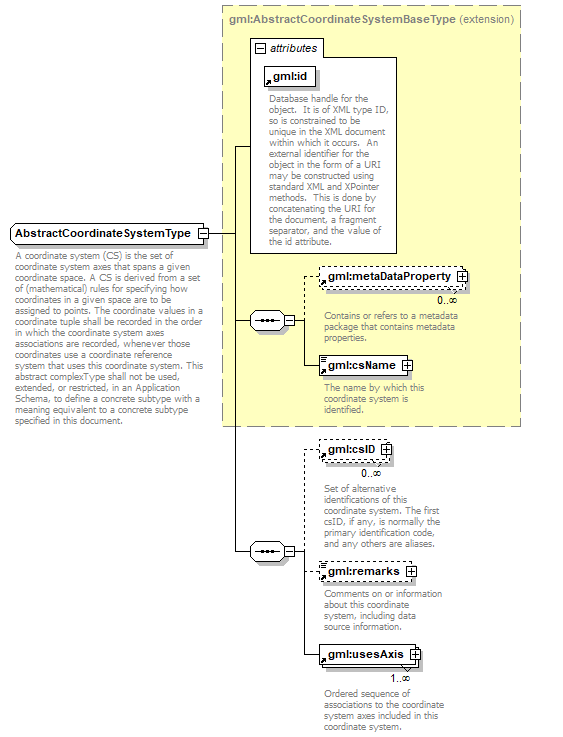| diagram |  |
||||||||||||||
| namespace | http://www.opengis.net/gml | ||||||||||||||
| type | extension of gml:AbstractCoordinateSystemBaseType | ||||||||||||||
| properties |
|
||||||||||||||
| children | gml:metaDataProperty gml:csName gml:csID gml:remarks gml:usesAxis | ||||||||||||||
| used by | |||||||||||||||
| attributes |
|
||||||||||||||
| annotation |
|
||||||||||||||
| source | <xs:complexType name="AbstractCoordinateSystemType" abstract="true"> <xs:annotation> <xs:documentation>A coordinate system (CS) is the set of coordinate system axes that spans a given coordinate space. A CS is derived from a set of (mathematical) rules for specifying how coordinates in a given space are to be assigned to points. The coordinate values in a coordinate tuple shall be recorded in the order in which the coordinate system axes associations are recorded, whenever those coordinates use a coordinate reference system that uses this coordinate system. This abstract complexType shall not be used, extended, or restricted, in an Application Schema, to define a concrete subtype with a meaning equivalent to a concrete subtype specified in this document. </xs:documentation> </xs:annotation> <xs:complexContent> <xs:extension base="gml:AbstractCoordinateSystemBaseType"> <xs:sequence> <xs:element ref="gml:csID" minOccurs="0" maxOccurs="unbounded"> <xs:annotation> <xs:documentation>Set of alternative identifications of this coordinate system. The first csID, if any, is normally the primary identification code, and any others are aliases. </xs:documentation> </xs:annotation> </xs:element> <xs:element ref="gml:remarks" minOccurs="0"> <xs:annotation> <xs:documentation>Comments on or information about this coordinate system, including data source information. </xs:documentation> </xs:annotation> </xs:element> <xs:element ref="gml:usesAxis" maxOccurs="unbounded"> <xs:annotation> <xs:documentation>Ordered sequence of associations to the coordinate system axes included in this coordinate system. </xs:documentation> </xs:annotation> </xs:element> </xs:sequence> </xs:extension> </xs:complexContent> </xs:complexType> |
XML Schema documentation generated by XMLSpy Schema Editor http://www.altova.com/xmlspy